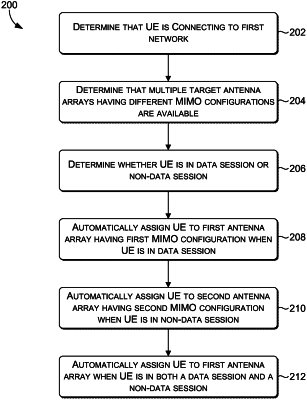| CPC H04W 36/22 (2013.01) [H04B 7/0413 (2013.01); H04W 28/0252 (2013.01); H04W 36/0027 (2013.01)] | 16 Claims |

|
1. A method for directing a user equipment (UE) connecting to a first network based on evolved packet system fallback (ESPFB) procedures or inter radio access technology handover (IRATHO) procedures from a second network to an optimal antenna array, the method comprising:
determining that the UE is connecting to the first network from the second network, wherein the first network is a long term evolution (LTE) network or a 5G non-standalone (NSA) network and the second network is a 5G standalone (SA) network;
determining, at the second network, whether the UE is in a data session or in a non-data session based on a last-assigned 5G quality of service indicator (5QI) bearer of the UE;
automatically assigning the UE to a first antenna array on the first network having a first multiple input multiple output (MIMO) configuration when the UE is determined to be in the data session; and
automatically assigning the UE to a second antenna array on the first network that is associated with different LTE layers than the first antenna array and that has a second MIMO configuration with fewer layers than the first MIMO configuration when the UE is determined to be in the non-data session.
|
|
9. A non-transitory computer-readable media comprising executable instructions that, in response to execution, cause a network device comprising one or more processors to perform operations in a radio access network (RAN) for directing a user equipment (UE) connecting to a first network based on evolved packet system fallback (ESPFB) procedures or inter radio access technology handover (IRATHO) procedures from a second network to an optimal antenna array, the executable instructions comprising the steps of:
determining that the UE is connecting to the first network from the second network, wherein the first network is a long term evolution (LTE) network or a 5G non-standalone (NSA) network and the second network is a 5G standalone (SA) network;
determining, at the second network, whether the UE is in a data session or in a non-data session based on a last-assigned 5G quality of service indicator (5QI) bearer of the UE;
automatically assigning the UE to a first antenna array on the first network having a first multiple input multiple output (MIMO) configuration when the UE is determined to be in the data session; and
automatically assigning the UE to a second antenna array on the first network that is associated with different LTE layers than the first antenna array and that has a second MIMO configuration with fewer layers than the first MIMO configuration when the UE is determined to be in the non-data session.
|
|
14. A system for directing a user equipment (UE) connecting to a first network based on evolved packet system fallback (ESPFB) procedures or inter radio access technology handover (IRATHO) procedures from a second network to an optimal antenna array, the system comprising:
a network device comprising one or more processors; and
a non-transitory computer-readable media comprising executable instructions that, in response to execution, cause the network device to perform operations in a radio access network (RAN), the executable instructions comprising the steps of:
determining that the UE is connecting to the first network from the second network, wherein the first network is a long term evolution (LTE) network or a 5G non-standalone (NSA) network and the second network is a 5G standalone (SA) network;
determining, at the second network, whether the UE is in a data session or in a non-data session based on a last-assigned 5G quality of service indicator (5QI) bearer of the UE;
automatically assigning the UE to a first antenna array on the first network having a first multiple input multiple output (MIMO) configuration when the UE is determined to be in the data session; and
automatically assigning the UE to a second antenna array on the first network that is associated with different LTE layers than the first antenna array and that has a second MIMO configuration with fewer layers than the first MIMO configuration when the UE is determined to be in the non-data session.
|